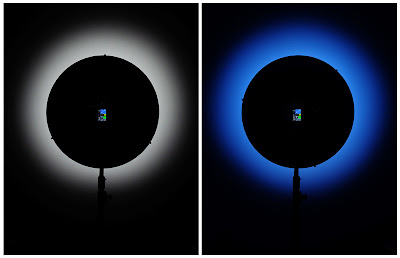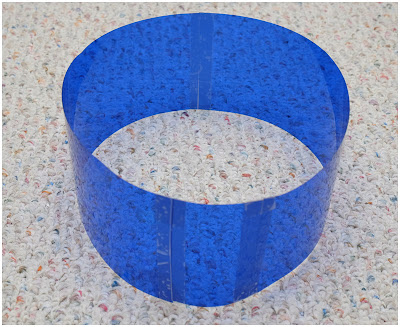How to Gel a Beauty Dish, v.2.0

One thing I have learned about light and lighting: there's always different—and often better—way to do something.
A few months ago we ran a piece on gelling various soft light modifiers, wherein I listed my go-to ways to color soft light. But someone in the comments offered a different way—a way better way—and I have been using it ever since. Here's what he suggested.
__________
First, if you are interested in ways to gel other big light sources, the original post (beauty dish portion since updated) is here. And many thanks to commenter Andrei Popovici for the tip.
What Andrei suggested, and I have since adopted, is to strip-gel the space between the dish and the internal shield/reflector. It works great, with perfect coverage from just a 12x12" gel, as you can see above. And if you do a good job cutting the gels you don't even need any gaff to mount it.
Here's how:

First, measure the distance between the internal base of your dish and the bare-bulb blocking shield. Add about a half inch to that, as that will make things easier.
I was able to cut my 12x12" gel into three strips with enough coverage depth. Next, I taped them into one long strip and measured a snug fit around the light blocker assembly. Do this tape-measure style and keep your cut lines perpendicular and you'll thank yourself later for the smooth, friction fit. Otherwise, you'll have to use tape to mount it.
With the long strip taped, measured and cut, I taped the ends together to make a little gel donut:

If your strips are of slightly different widths, you should make sure to align one long edge and use that for the rear contact for no light leaks. To mount it, just slide it onto your dish, thusly:

And there you go. One 12x12" sheet and perfect coverage. Your mileage may vary depending on the dish. Some blockers are smaller, and/or deeper. In that case you'll need more width but less length. I had plenty left over, so I am guessing there is a gel-strip-Scotch-tape puzzle that will work for both.
Reader Dave Bird notes that you could have issues with heat build-up with modeling lights. Agreed. If perfect coverage is not necessary (i.e., for warming of a key light, as is the most common dish-gelling instance) you could always leave a space at the back for air to escape.
And if you are full-covering with a dark gel (as in above) you may want to periodically remove and reinstall the gel to bleed heat. And watch the model light intensity, of course.
But overall I find this preferable. They are super-easy to store and mount, too. And the coverage can be perfect if needed:

Thanks again to Andrei for the tip. We stand on the shoulders of giants.
__________
New to Strobist? Start here | Or jump right to Lighting 101
My new book: The Traveling Photograher's Manifesto
Permalink
<< Home